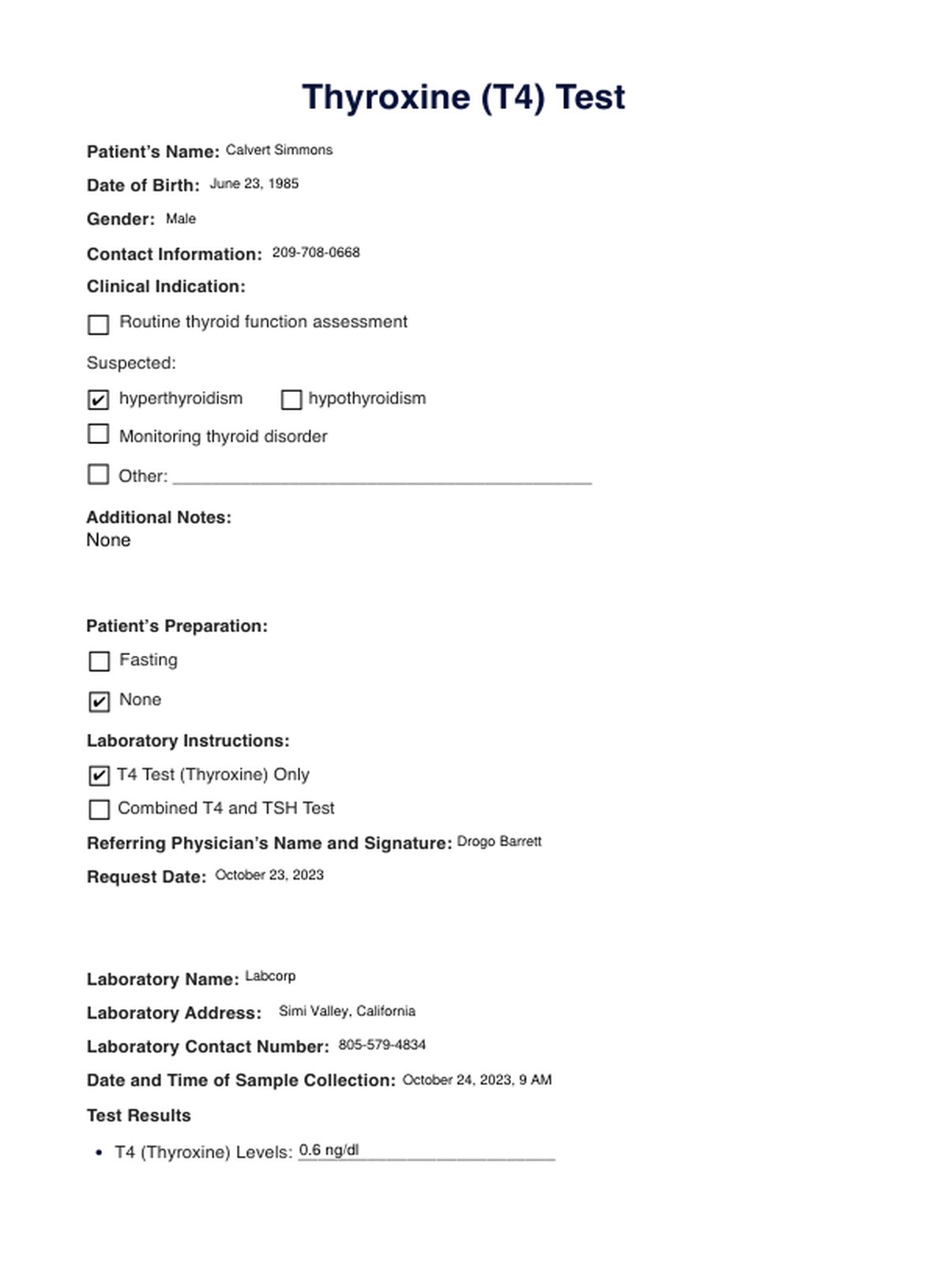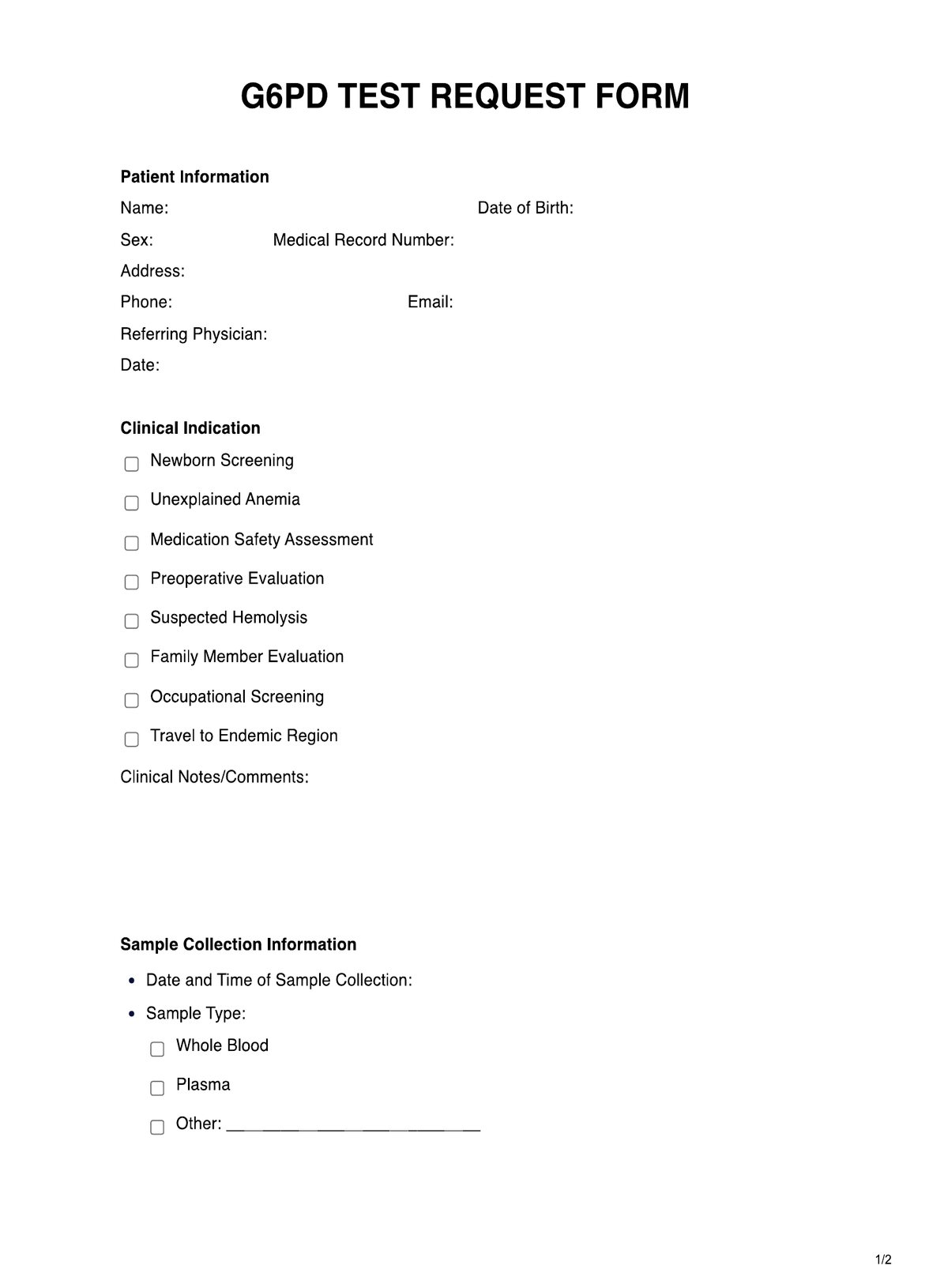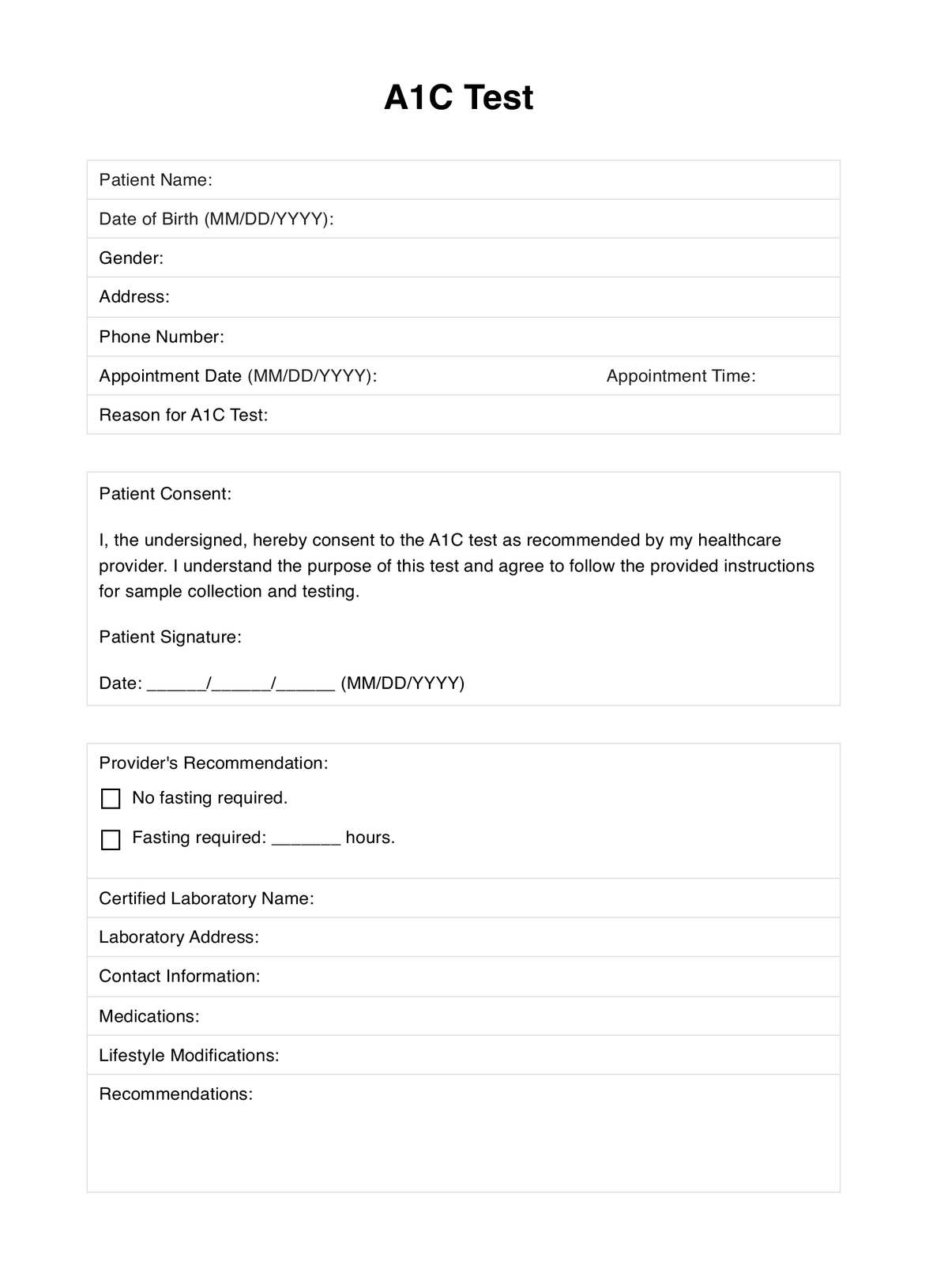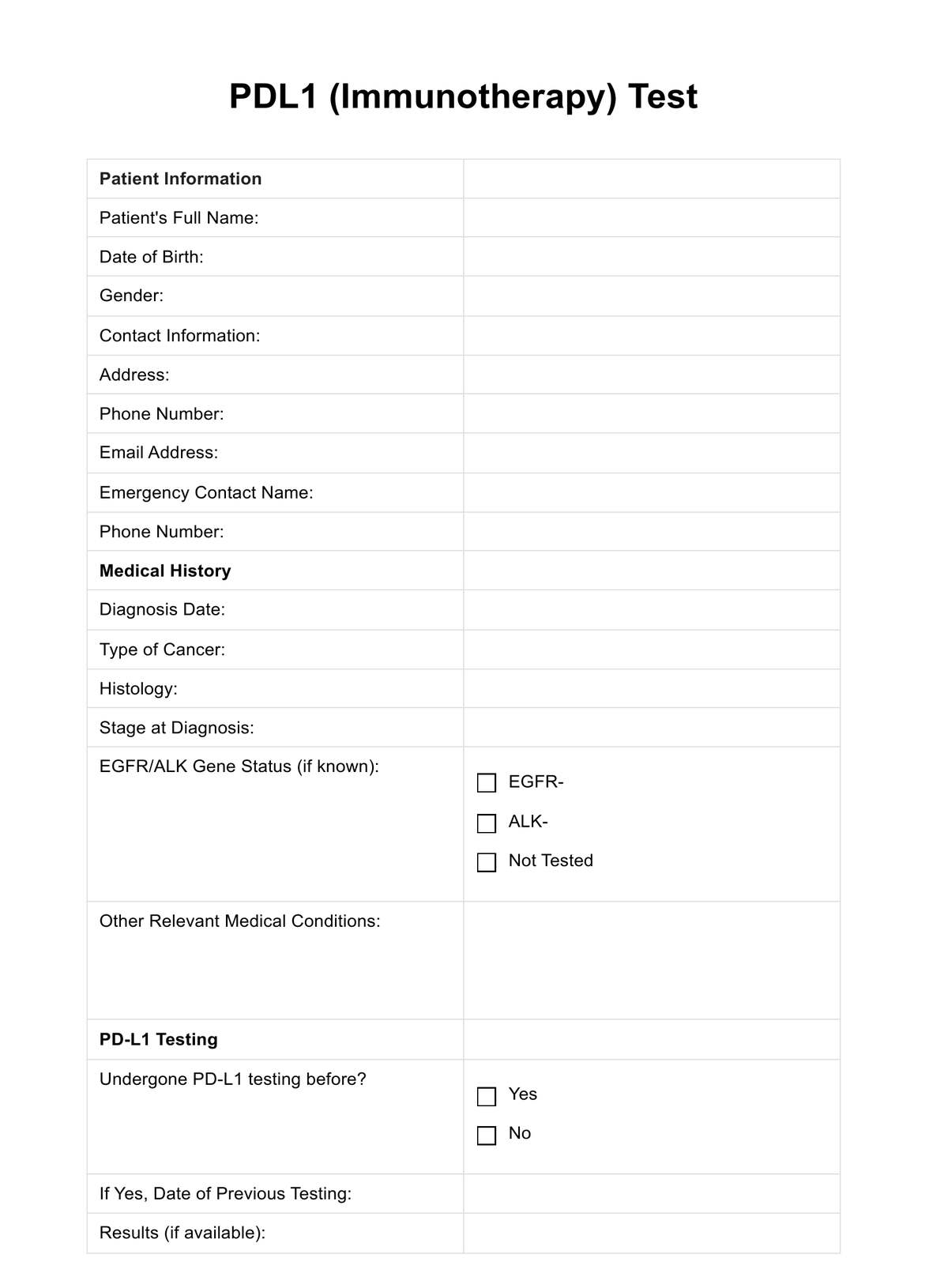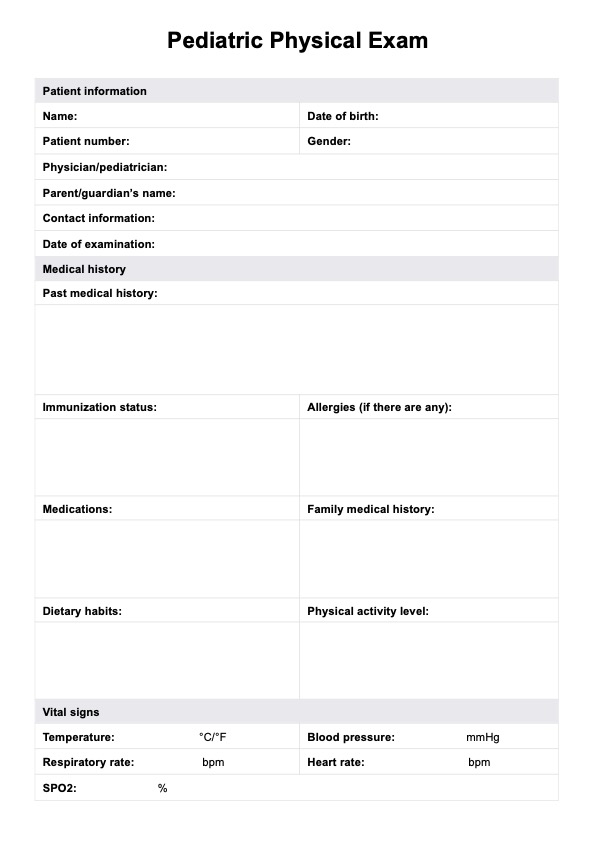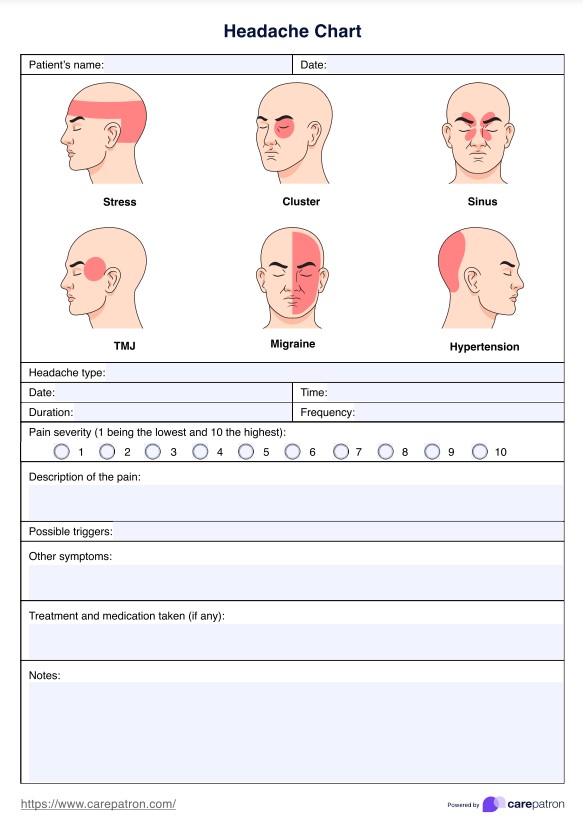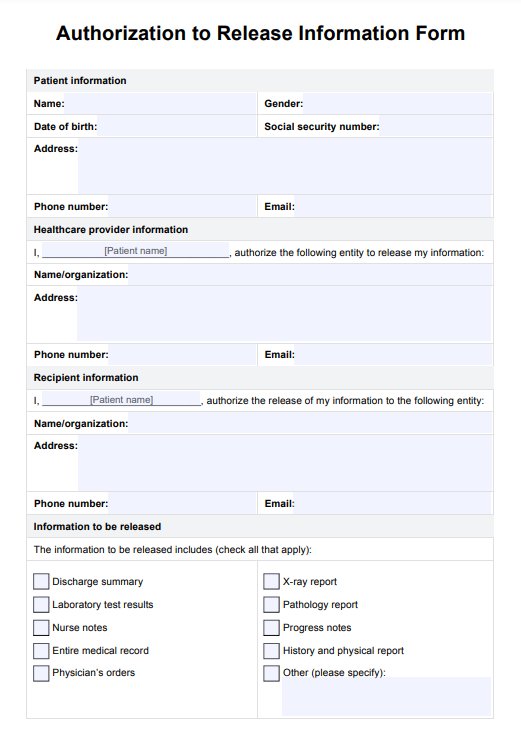T4
Learn more about the Thyroxine (T4) Test, its relevance, function, and result interpretation with our guide packed with information and a free template.


What is a T4 Test?
A T4 or Thyroxine test is a diagnostic blood test that’s designed to evaluate thyroid conditions. To elaborate, the test is meant to check T4, the primary hormone produced by the thyroid gland that regulates particular body functions.
There are actually two types of tests to assess the T4 levels to measure the two distinct forms of T4 that exist in the body, which are free T4, which can easily penetrate bodily tissues when needed, and bound T4, which is the variant that binds to protein but cannot enter the body’s tissues. One of the tests is the Total T4 Test, which measures both the bound and free T4 levels in the bloodstream and can provide a comprehensive overview.
The other test, the Free T4 Test, specifically quantifies the concentration of free T4 and is often favored when evaluating thyroid function because of its accuracy. Aside from the aforementioned T4 tests, healthcare practitioners often request a TSH or Thyroid-Stimulating Hormone Test to help them with the assessment of thyroid function.
Similar to other blood tests, the practitioner in charge will collect a blood sample from a patient who has, if needed, temporarily stopped taking a particular medication that may affect the results’ accuracy. Afterward, the blood sample will be sent to the laboratory for processing to produce results that will be analyzed and interpreted by the referring physician.
T4 Template
T4 Example
How does it work?
Step One. Obtain a Copy of the Template
Accessing and downloading the template to secure a digital and printable copy of the Thyroxine (T4) test is as simple as doing one of the two steps below:
- Clicking the “Download Template” or “Use Template” button
- Searching for “Thyroxine (T4) Test” on Carepatron’s template library’s search bar on the app or website
Step Two. Create the Request
Whether you interview, assess, or examine your patient, if your suspicions have a basis, like exhibited symptoms, medical history, etc., you can request the T4 test. Create a request form by filling out the essential details in the request form section of the template.
Step Three. Submit the Form
Depending on your patient’s current condition, either they or a fellow practitioner caring for the same patient can bring the request form to a phlebotomist or practitioner who’s qualified to collect a blood sample from the patient. The document will serve as proof that the patient needs the test.
Step Four. Write Down Interpretation
When you have your hand on the results, you may proceed with analysis and interpretation. For information you can refer back to during diagnosis or formulation of medical intervention, it’s best to write down your observations and findings in the document section of the template.
Step Five. Store the Template Securely
Once the template has served its purpose, don’t forget to securely store it in places that are secure but also easily accessible when needed. Digital copies are recommended to be stored in Carpeatron, a HIPAA-compliant, free patient records software that can safeguard all medical records relevant to your patient.
When would you use this test?
There are multiple reasons or circumstances that may prompt a medical professional to request or use a Thyroxine (T4) Test. Some of them are:
Diagnosing Thyroid Disorders
If the practitioner suspects that their patient has a thyroid disorder based on their symptoms, whether it’s hyperthyroidism, which is an overactive thyroid, or hypothyroidism, which is an underactive thyroid, they will have the patient undergo a Thyroxine (T4) test.
Some symptoms indicating a thyroid disorder are dryness, irritation, puffiness of eyes, skin dryness, hair loss, sleep disturbances, insomnia, weight fluctuations, or tremors in the hands.
Determining Specific Issue
If the patient has undergone the thyroid-stimulating hormone test (TSH) and has abnormalities, the practitioner may have the patient undergo the T4 Test to determine the specific issue related to the thyroid gland.
Monitoring Diagnosed Thyroid Issues
If the patient’s thyroid issue is known and diagnosed, the T4 test can be used to assess the progression or progress and improvement of the condition, especially if they’re taking medication for the condition.
Ultimately, however, if there are other circumstances or situations in which you, as the referring physician, believe that may need a Thyroxine or T4 test, you may request and have your patient undergo one.
What do the results mean?
Oftentimes, interpreting the results of a Thyroxine (T4) test may require multiple factors. Not only should you consider the patient’s medical history and observed symptoms but also the results of other thyroid function tests like the TSH (Thyroid Stimulating Hormone) Test.
Before proceeding with the general interpretations of T4 and TSH levels, here are the two normal levels of T4 depending on the test:
- Range of Normal Levels of Total T4: 5-12 mcg/dl
- Range of Normal Levels of Free T4: 0.8-1.8 ng/dl
Moving on to the interpretations, keep in mind that even if there’s a provided range of normal levels, numbers may vary from one laboratory to another.
- Normal T4 Levels: T4 levels within the established normal range indicate a well-functioning thyroid gland.
- High T4 Levels: T4 levels that are elevated signal an overactive thyroid, indicating that the patient may have hyperthyroidism. Symptoms they may exhibit are weight loss and a quick heart rate.
- Low T4 Levels: Conversely, T4 levels less than the lower limit of the provided range may signal an underactive thyroid or hypothyroidism. Some symptoms of said condition are fatigue and a slower heart rate.
Research & Evidence
There are multiple studies and articles that highlight and underscore the usefulness and importance of the Thyroxine or T4 test as well as its limitations. Here’s an overview of two which we’ve found:
According to a study entitled “Interpretation of TSH and T4 for diagnosing minor alterations in thyroid function: a comparative analysis of two separate longitudinal cohorts,” TSH outperforms T4 because of its heightened sensitivity and accuracy in assessing thyroid function. Compared to T4, the TSH can detect the more subtle differences in thyroid function. Therefore, although not stated in the study, if a practitioner wishes to utilize the T4 test, for accuracy’s sake, the patient must also undergo a TSH test.
As stated in a reputable informative article, healthcare providers predominantly rely on the Free T4 tests compared to the total T4 tests when assessing thyroid function because of their accuracy. The article also provided a statement that supports combining the T4 test with a TSH test for a more precise picture of a patient’s thyroid function.
Based on the aforementioned study and article findings, the Thyroxine or T4 test is still a valuable diagnostic and monitoring tool. However, for a more comprehensive and accurate assessment of a patient’s thyroid function, it’s recommended that the practitioner have the patient undergo a combination of T4 and TSH.
References
- Andersen, S., Karmisholt, J., Bruun, N. H., Riis, J., Noahsen, P., Westergaard, L., & Andersen, S. (2022). Interpretation of TSH and T4 for diagnosing minor alterations in thyroid function: a comparative analysis of two separate longitudinal cohorts. Thyroid Research, 15(1). https://doi.org/10.1186/s13044-022-00137-1
- Professional, C. C. M. (n.d.). T4 (Thyroxine) test. Cleveland Clinic. https://my.clevelandclinic.org/health/diagnostics/24235-thyroxine-t4-test
Commonly asked questions
General physicians, their assistants, nurses, and specialists who manage and treat thyroid gland problems, like endocrinologists, are the practitioners who typically request a T4 test.
T4 tests, combined with a TSH test for accuracy, are often used to diagnose and manage thyroid disorders.
Collecting a sample to process for the T4 test will take only a few minutes. However, results may only be available after one to two business days or even longer, depending on the laboratory.



